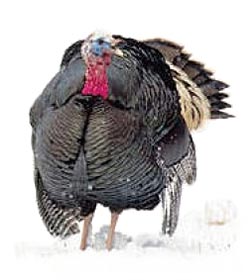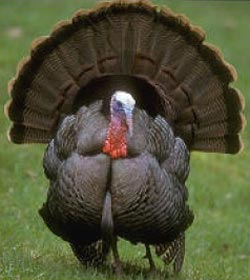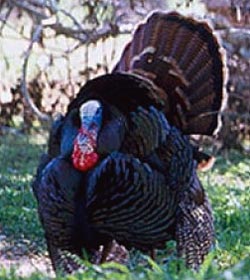Turkeys in Idaho
Wild turkeys are not native to Idaho and were first transplanted here in 1961. A total of 6,256 Merriam’s, Eastern, Rio Grande, and hybrid wild turkeys were trapped from ten states (including Idaho) and released between 1961 through 2008. Four thousand of these were Merriam’s wild turkeys.
- The Merriam’s wild turkey has been by far the most successful. This bird is widely distributed in the mountains of the Panhandle, Clearwater, and Southwest regions.
- The Rio Grande wild turkey was first introduced to Idaho in 1982. This subspecies is present in small numbers in riparian areas adjacent to the Snake, Boise, Payette, and Weiser rivers.
- The eastern wild turkey has been introduced to a few sites near Dworshak Reservoir, and some birds may still be found there.
- Hybrid wild turkeys occur in many areas of the state.
Turkey hunting opportunities are provided statewide; however, turkeys are most numerous in the Panhandle and Clearwater regions in north Idaho. Hunting opportunities abound on both public and private property.

Photo courtesy: commons.wikimedia.org

Photo courtesy: wikipedia.org

Photo courtesy: NWTF.org
Wild Turkeys are one of our largest wild birds. They stand 43 – 45 inches tall and can weigh up to 24 pounds.
They have long, powerful legs. Their wings seem short for such a large bird, but turkeys can quickly burst into flight. These quick bursts allow them to glide for up to a mile to get away from danger. Scientists have clocked turkeys flying at 60 miles per hour! Because turkeys are heavy, they cannot fly far. Instead, they rely on their legs to get where they need to go.
Turkeys are brownish over most of their bodies. The males, called “toms,” have a bronze sheen to their feathers. The wing feathers are barred with black and white. Females, called “hens,” have a few feathers on their heads, but the toms have no feathers. The tom’s bare skin is colorful, with a white forehead, blue face and red neck. In the spring, these colors become very bright, and are part of the male’s breeding display.
Turkeys can live in many kinds of habitats. You can find turkeys in forested openings, grasslands, and even swamps. Their diet is made up of acorns, seeds, nuts, fruits, buds, insects and small animals like frogs, salamanders, and snakes. Family groups of hens and young turkeys spend the day looking for food. At sundown, the flock will fly into large trees where they will roost for the night.
Top of page
